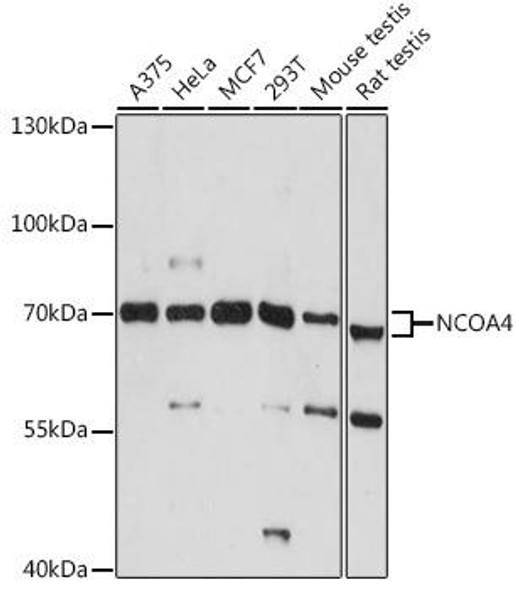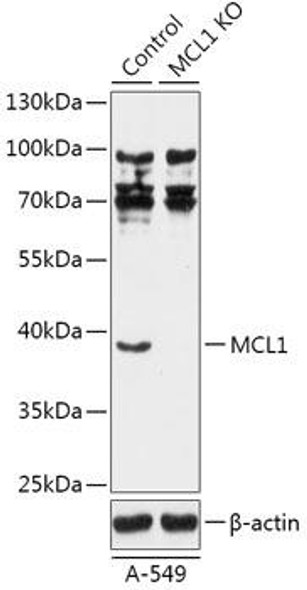Description
Anti-STIM1 Antibody (CAB19894)[KO Validated]
The KO Validated STIM1 Rabbit Polyclonal Antibody (CAB19894) is a powerful tool for researchers studying STIM1, a key player in calcium signaling pathways. This antibody, produced in rabbits, is highly specific for human samples and has been rigorously validated for use in a variety of applications, including Western blotting.STIM1 is a critical regulator of calcium influx in response to cellular signals, playing a crucial role in processes such as cell growth, differentiation, and immune response.
Dysregulation of STIM1 has been implicated in various diseases, making it an attractive target for therapeutic intervention.By using the KO Validated STIM1 Rabbit Polyclonal Antibody, researchers can confidently study the expression and function of STIM1 in different cell types and conditions. This antibody enables precise detection and analysis of STIM1 protein levels, making it an indispensable tool for advancing our understanding of calcium signaling and its implications in disease pathology.
| Antibody Name: | Anti-STIM1 Antibody [KO Validated] |
| Antibody SKU: | CAB19894 |
| Antibody Size: | 20uL, 50uL, 100uL |
| Application: | WB IF |
| Reactivity: | Human, Mouse, Rat |
| Host Species: | Rabbit |
| Immunogen: | Recombinant protein of human STIM1. |
| Application: | WB IF |
| Recommended Dilution: | WB 1:200 - 1:2000 IF 1:50 - 1:200 |
| Reactivity: | Human, Mouse, Rat |
| Positive Samples: | HeLa |
| Immunogen: | Recombinant protein of human STIM1. |
| Purification Method: | Affinity purification |
| Storage Buffer: | Store at -20°C. Avoid freeze / thaw cycles. Buffer: PBS with 0.02% sodium azide, 50% glycerol, pH7.3. |
| Isotype: | IgG |
| Sequence: | Email for sequence |
| Gene ID: | 6786 |
| Uniprot: | Q13586 |
| Cellular Location: | Cell membrane, Cytoplasm, Endoplasmic reticulum membrane, Single-pass type I membrane protein, cytoskeleton |
| Calculated MW: | 62kDa/77kDa |
| Observed MW: | 80KDa |
| Synonyms: | STIM1, D11S4896E, GOK, IMD10, STRMK, TAM, TAM1 |
| Background: | This gene encodes a type 1 transmembrane protein that mediates Ca2+ influx after depletion of intracellular Ca2+ stores by gating of store-operated Ca2+ influx channels (SOCs). It is one of several genes located in the imprinted gene domain of 11p15.5, an important tumor-suppressor gene region. Alterations in this region have been associated with the Beckwith-Wiedemann syndrome, Wilms tumor, rhabdomyosarcoma, adrenocrotical carcinoma, and lung, ovarian, and breast cancer. This gene may play a role in malignancies and disease that involve this region, as well as early hematopoiesis, by mediating attachment to stromal cells. Mutations in this gene are associated with fatal classic Kaposi sarcoma, immunodeficiency due to defects in store-operated calcium entry (SOCE) in fibroblasts, ectodermal dysplasia and tubular aggregate myopathy. This gene is oriented in a head-to-tail configuration with the ribonucleotide reductase 1 gene (RRM1), with the 3' end of this gene situated 1.6 kb from the 5' end of the RRM1 gene. Alternative splicing of this gene results in multiple transcript variants. |
| UniProt Protein Function: | STIM1: Plays a role in mediating store-operated Ca(2+) entry (SOCE), a Ca(2+) influx following depletion of intracellular Ca(2+) stores. Acts as Ca(2+) sensor in the endoplasmic reticulum via its EF-hand domain. Upon Ca(2+) depletion, translocates from the endoplasmic reticulum to the plasma membrane where it activates the Ca(2+) release-activated Ca(2+) (CRAC) channel subunit, TMEM142A/ORAI1. Forms homooligomers and heterooligomers with STIM2. Interacts with ORAI1. Interacts with MAPRE1; probably required for targeting to the growing microtubule plus ends. Interacts with EFCAB4B/CRACR2A; the interaction is direct and takes place in absence of Ca(2+). Forms a complex with EFCAB4B/CRACR2A and ORAI1 at low concentration of Ca(2+), the complex dissociates at elevated Ca(2+) concentrations. Interacts with TMEM66/SARAF, promoting a slow inactivation of STIM1-dependent SOCE activity, possibly by facilitating the deoligomerization of STIM1. Ubiquitously expressed in various human primary cells and tumor cell lines. |
| UniProt Protein Details: | Protein type:Membrane protein, integral; Endoplasmic reticulum; Calcium-binding Chromosomal Location of Human Ortholog: 11p15.5 Cellular Component: microtubule; endoplasmic reticulum membrane; integral to plasma membrane; endoplasmic reticulum; integral to endoplasmic reticulum membrane Molecular Function:identical protein binding; microtubule plus-end binding; protein binding; calcium ion binding Biological Process: activation of store-operated calcium channel activity; calcium ion transport; regulation of calcium ion transport; detection of calcium ion; blood coagulation Disease: Myopathy, Tubular Aggregate, 1; Immunodeficiency 10 |
| NCBI Summary: | This gene encodes a type 1 transmembrane protein that mediates Ca2+ influx after depletion of intracellular Ca2+ stores by gating of store-operated Ca2+ influx channels (SOCs). It is one of several genes located in the imprinted gene domain of 11p15.5, an important tumor-suppressor gene region. Alterations in this region have been associated with the Beckwith-Wiedemann syndrome, Wilms tumor, rhabdomyosarcoma, adrenocrotical carcinoma, and lung, ovarian, and breast cancer. This gene may play a role in malignancies and disease that involve this region, as well as early hematopoiesis, by mediating attachment to stromal cells. Mutations in this gene are associated with fatal classic Kaposi sarcoma, immunodeficiency due to defects in store-operated calcium entry (SOCE) in fibroblasts, ectodermal dysplasia and tubular aggregate myopathy. This gene is oriented in a head-to-tail configuration with the ribonucleotide reductase 1 gene (RRM1), with the 3' end of this gene situated 1.6 kb from the 5' end of the RRM1 gene. Alternative splicing of this gene results in multiple transcript variants. [provided by RefSeq, May 2013] |
| UniProt Code: | Q13586 |
| NCBI GenInfo Identifier: | 21070997 |
| NCBI Gene ID: | 6786 |
| NCBI Accession: | NP_003147.2 |
| UniProt Secondary Accession: | Q13586,Q8N382, E9PQJ4, |
| UniProt Related Accession: | Q13586 |
| Molecular Weight: | 62,133 Da |
| NCBI Full Name: | stromal interaction molecule 1 isoform 2 |
| NCBI Synonym Full Names: | stromal interaction molecule 1 |
| NCBI Official Symbol: | STIM1 |
| NCBI Official Synonym Symbols: | GOK; TAM; TAM1; IMD10; STRMK; D11S4896E |
| NCBI Protein Information: | stromal interaction molecule 1 |
| UniProt Protein Name: | Stromal interaction molecule 1 |
| UniProt Gene Name: | STIM1 |
| UniProt Entry Name: | STIM1_HUMAN |


![Anti-STIM1 Antibody [KO Validated] (CAB19894)](https://cdn11.bigcommerce.com/s-h68l9z2lnx/product_images/d/112/A19894_1__55591.jpg)




